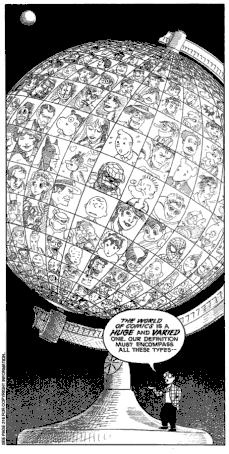Scott McCloud’s Definition of Comics.
by Dylan Horrocks
(first published in the Comics Journal #234, June 2001)
© Copyright 2001 Dylan Horrocks
To Build a Nation
‘Nationalism is not the awakening of nations to self-consciousness: it invents nations where they do not exist.’
(Ernst Gellner, Thought & Change).
‘In fact, all communities larger than primordial villages of face-to-face contact (and perhaps even these) are imagined.’
(Benedict Anderson, Imagined Communities).
When Scott spoke at the 1998 Small Press Expo, he called the convention ‘a gathering of the tribes.’ Indeed, while comics have been becoming less and less a mass medium since the 1950s, they do seem to have become more like a community. Like any community, we have our shared history, mythology and culture - or rather, several related cultures and subcultures. For most of their history, these comics tribes have been ignored by the wider world, scratching out a nomadic living at the margins of the arts. But now, after decades (or centuries, depending on which version of history you subscribe to) of poverty and prejudice, comics are at last asserting themselves. Visionaries have arisen, determined to unite these feuding, demoralized tribes into a single powerful nation, ready to escape the ghettoes and stake a claim among the Great Nations of the art world.
Scott is perhaps the most eloquent of these visionaries. (4) And if Understanding Comics is his manifesto, it is also a map of our ‘homeland’ and its place in the world - an attempt to claim territory in the contested spaces of history, theory, art criticism, communication, etc. It’s appropriate, then, that Understanding Comics is full of geographical metaphors (both verbal and visual): globes, territories, map-like grids, spaces being traversed . . .

pg.4, panel 1 pg.214
Scott illustrates his ideas by constructing a series of diagrams - or charts - on which he can ‘map’ similarities and differences as spatial relationships:
pg.51, panel 1
pg.75, last panel
pg.183, panel 2
His textual vocabulary, too, is often built on these geographical metaphors (italics are mine):
‘If we incorporate language and other icons into the chart, we can begin to build a comprehensive map - of the universe called comics.’ (pg.51)
‘No schools of art are banished by our definition, no philosophies, no movements, no ways of seeing are out of bounds!’ (pg.22)
‘All the things we experience in life can be separated into two realms, the realm of the concept - and the realm of the sense.’ (pg.39)
‘Since cartoons already exist as concepts for the reader, they tend to flow easily through the conceptual territory between panels. . . . But realistic images have a bumpier ride. Theirs is a primarily visual existence which doesn’t pass easily into the realm of ideas.’ (pg.90-91)
‘The work of Dadaists, Futurists and various individual artists of the modern era breached the frontier between appearance and meaning!’(pg.148)
Little wonder, then, that the one ornament sitting amidst the clutter of tools and paper that is McCloud’s studio should be a globe (see pg.2 and following). (5)
Footnotes:
In Reinventing Comics (Paradox Press, 2000), Scott’s recent follow-up to Understanding Comics, he reinforces this nation-building metaphor. For example, see page 7, panel 7 (which shows Scott sitting on a flagpole - which bears a ‘comics’ flag - describing himself as a "comics loyalist") or page 19, panel 3 (in which he refers to comics being ‘relegated to minority status...’). Back
Again, Reinventing Comics returns to these geographical metaphors (as well as reinforcing Scott’s point that ‘space’ is central to the nature of comics). For example, see page 19, panel 7 (‘The best way to understand the nature of our environment is to return to it from as many vantage points as possible - - triangulating its shape from without’) or page 53, panel 7 (‘The "fine art" of comics is an equally unexplored continent of possibilities.’). Diagrams and globes abound throughout, of course. Back
© Copyright 2000 Dylan Horrocks